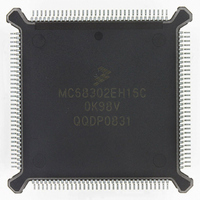MC68302EH16C Freescale Semiconductor, MC68302EH16C Datasheet - Page 115

MC68302EH16C
Manufacturer Part Number
MC68302EH16C
Description
IC MPU MULTI-PROTOCOL 132-PQFP
Manufacturer
Freescale Semiconductor
Datasheets
1.MC68302AG20C.pdf
(4 pages)
2.MC68302AG20C.pdf
(2 pages)
3.MC68302AG20C.pdf
(13 pages)
4.MC68302EH16C.pdf
(481 pages)
Specifications of MC68302EH16C
Processor Type
M683xx 32-Bit
Speed
16MHz
Voltage
5V
Mounting Type
Surface Mount
Package / Case
132-MQFP, 132-PQFP
Controller Family/series
68K
Core Size
32 Bit
Ram Memory Size
1152Byte
Cpu Speed
16MHz
No. Of Timers
3
Embedded Interface Type
SCP, TDM
Digital Ic Case Style
PQFP
Rohs Compliant
Yes
Family Name
M68000
Device Core
ColdFire
Device Core Size
32b
Frequency (max)
16MHz
Instruction Set Architecture
RISC
Supply Voltage 1 (typ)
5V
Operating Temp Range
0C to 70C
Operating Temperature Classification
Commercial
Mounting
Surface Mount
Pin Count
132
Package Type
PQFP
Lead Free Status / RoHS Status
Lead free / RoHS Compliant
Features
-
Lead Free Status / Rohs Status
RoHS Compliant part
Electrostatic Device
Available stocks
Company
Part Number
Manufacturer
Quantity
Price
Company:
Part Number:
MC68302EH16C
Manufacturer:
Freescale Semiconductor
Quantity:
135
Company:
Part Number:
MC68302EH16C
Manufacturer:
PANA
Quantity:
99
Company:
Part Number:
MC68302EH16C
Manufacturer:
Freescale Semiconductor
Quantity:
10 000
Part Number:
MC68302EH16C
Manufacturer:
FREESCALE
Quantity:
20 000
Company:
Part Number:
MC68302EH16CB1
Manufacturer:
Freescale Semiconductor
Quantity:
10 000
Company:
Part Number:
MC68302EH16CR2
Manufacturer:
Freescale Semiconductor
Quantity:
10 000
- MC68302AG20C PDF datasheet
- MC68302AG20C PDF datasheet #2
- MC68302AG20C PDF datasheet #3
- MC68302EH16C PDF datasheet #4
- Current page: 115 of 481
- Download datasheet (2Mb)
TSRCLK1—Three-state RCLK1
DBRG1—Disable BRG1
Bits 10 - 0—Reserved. Should be written with zeros.
3.9.1 Freeze Control
Used to freeze the activity of selected peripherals, FRZ is useful for system debugging pur-
poses. When FRZ is asserted:
MOTOROLA
• The CP main controller freezes its activity on the next clock (CLKO) and will continue
• The IDMA completes any bus cycle that is in progress (after DTACK is asserted) and
• Each timer can be programmed to freeze by setting the appropriate bit in the SCR. After
0 = Normal operation
1 = The RCLK1 pin is three-stated. This option may be used to prevent contention on
0 = Normal operation
1= The BRG1 pin is disabled and is driven high. This option should be chosen if it is
in a frozen state as long as FRZ remains asserted. No new interrupt requests and no
memory accesses (internal or external) will occur, and the main controller will not ac-
cess the serial channels.
releases bus ownership. No further bus cycles will be started as long as FRZ remains
asserted.
a one-clock (CLKO) delay, the selected timers will freeze their activity (count, capture)
as long as FRZ remains asserted.
reduce power. An external pullup should be used if TCLK1 is not driven externally.
TSTCLK1 may be toggled at any time, but the SCC1 transmitter should be disabled
and re-enabled if any dynamic change is made on TSTCLK1 during the operation
of the SCC1 transmitter.
the RCLK1 pin if an external clock is provided to the RCLK1 pin while the SCC1
baud rate generator is output on RCLK1. This option may also be chosen if it is re-
quired to run the SCC1 baud rate generator at high speed (for instance in a high
speed UART application), but the RCLK1 output is not needed, and it is desired to
reduce power. An external pullup should be used if RCLK1 is not driven externally.
TSRCLK1 may be toggled at any time, but the SCC1 receiver should be disabled
and re-enabled if any dynamic change is made on TSRCLK1 during the operation
of the SCC1 receiver.
required to run the SCC1 baud rate generator at high speed, but the BRG1 output
is not needed and it is desired to reduce power. Although DBRG1 may be modified
at any time, the user should note that glitches on BRG1 are not prevented by the
MC68302 when the state of DBRG1 is changed.
Regardless of whether or not the freeze logic is used, FRZ must
be negated during system reset.
MC68302 USER’S MANUAL
NOTE
System Integration Block (SIB)
3-65
Related parts for MC68302EH16C
Image
Part Number
Description
Manufacturer
Datasheet
Request
R
Part Number:
Description:
Manufacturer:
Freescale Semiconductor, Inc
Datasheet:

Part Number:
Description:
MC68302 Configuring the Chip Selects on the MC68302
Manufacturer:
Motorola / Freescale Semiconductor

Part Number:
Description:
MC68302 Design Concept - Expanding Interrupts on the MC68302
Manufacturer:
Motorola / Freescale Semiconductor

Part Number:
Description:
MC68302 MC68302 Adapting a WAN Controller to a LAN Environment
Manufacturer:
Motorola / Freescale Semiconductor

Part Number:
Description:
MC68302 EKB Applications - Power Measurements on the MC68302
Manufacturer:
Motorola / Freescale Semiconductor

Part Number:
Description:
MC68302 Interfacing the MC68020 to a Slave MC68302
Manufacturer:
Motorola / Freescale Semiconductor

Part Number:
Description:
MC68302 MC68302 Software Performance
Manufacturer:
Motorola / Freescale Semiconductor

Part Number:
Description:
MC68302 Evaluating EDX on the ADS302
Manufacturer:
Motorola / Freescale Semiconductor

Part Number:
Description:
MC68302 Design Advisory #1 - MC68SC302 Passive ISDN Protocol Engine
Manufacturer:
Motorola / Freescale Semiconductor

Part Number:
Description:
MC68302, MC68360, and MPC860 Characteristics and Design Notes for Crystal Feedback Oscillators
Manufacturer:
Motorola / Freescale Semiconductor
Part Number:
Description:
Mc68302 Integrated Multi-protocol Processor
Manufacturer:
Freescale Semiconductor, Inc
Datasheet:
Part Number:
Description:
Manufacturer:
Freescale Semiconductor, Inc
Datasheet:
Part Number:
Description:
Manufacturer:
Freescale Semiconductor, Inc
Datasheet:
Part Number:
Description:
Manufacturer:
Freescale Semiconductor, Inc
Datasheet:
Part Number:
Description:
Manufacturer:
Freescale Semiconductor, Inc
Datasheet:











